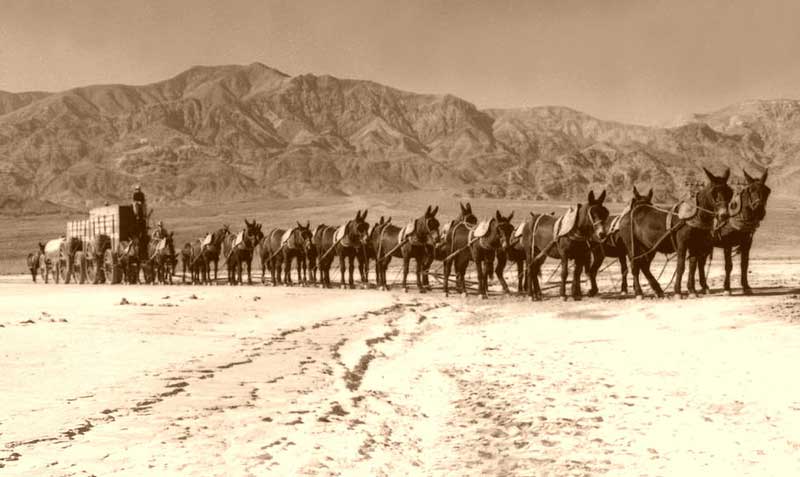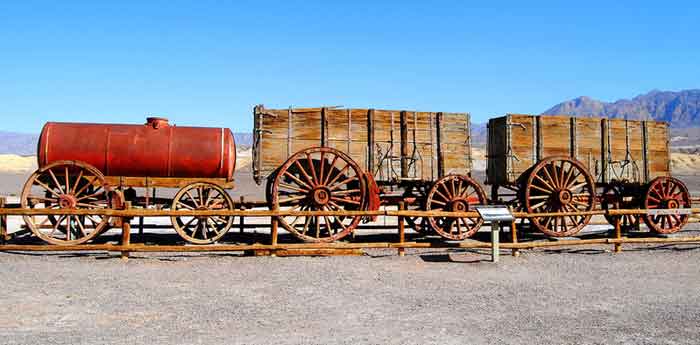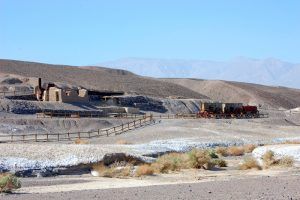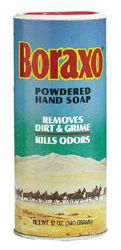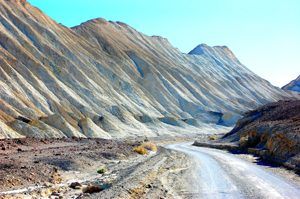For many people, nothing symbolizes Death Valley more than the famous Twenty Mule Teams. These “big teams” first pulled massive wagons hauling borax from William T. Coleman’s Harmony Borax Works near Furnace Creek to the railhead near Mojave, California, a grueling 165-mile, ten-day trip across primitive roads. Although the teams only ran for six years, from 1883 to 1889, they made an enduring impression of the Old West and Death Valley. This is primarily due to a successful advertising campaign promoting 20-Mule-Team Borax Soap and the long-running Death Valley Days radio and television program.
Twenty-mule teams were actually teams of eighteen mules and two horses attached to large wagons that hauled the borax from the mines to the closest railhead.
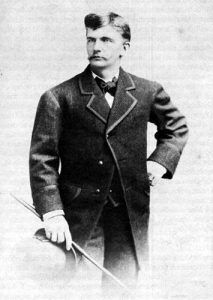
Francis “Borax” Smith
Though William T. Coleman is credited for the first to use the 20 mule teams, Francis “Borax” Smith had utilized 24-mule teams to haul borax in 30-ton loads in two large wagons across a 160-mile stretch of desert between Teel’s Marsh and Wadsworth, Nevada some six years before.
However, Coleman was the first to use these large mule teams in Death Valley. The wagons were among the largest ever pulled by draft animals, designed to carry 10 metric tons of borax ore at a time.
Two horses led the group. Though they were larger than the mules and had great strength for getting the wagons moving, they were not as well suited to the desert conditions as the mules. The 18 mules and two horses were latched to an 80-foot chain, which ran the team’s length. Although the driver also wielded a whip with a six-foot handle and a 22-foot lash, his primary method of giving orders lay in manipulating this chain called the jerk line. The team drivers, called muleskinners, were responsible for harnessing the mules each morning, inspecting each piece of harness, and hooking up the outfit. They were also responsible for caring for sick or injured animals and repairing the wagons. These men earned from $100 to $120 per month, very high wages for the time for their efforts. At the end of the day, men called “swampers” were responsible for un-harnessing the animals, gathering firewood, and cooking for the rest of the crew.
The rear wheels of these massive wagons measured seven feet high and were made of one-inch-thick iron. The wagon beds, constructed of solid oak, measured 16 feet long, were 6 feet deep, and weighed 7,800 pounds when empty. The first wagon was called the “trailer,” the second was the “tender,” and the water tank wagon brought up the rear. These water tanks carried 1,200 gallons of water to supply the mules and men en route. Water supplies were refilled at springs along the way, as carrying enough water for the entire trip was impossible. All total, with the mules, the caravan stretched over 180 feet and when loaded with ore, the total weight was 73,200 pounds. A loaded team traveled an average of only 17 miles a day.
Between 1883 and 1889, the twenty mule teams hauled more than 20 million pounds of borax out of the Valley. During those years, the teams ran like clockwork, completing the 330-mile round trip between the Harmony Borax Works and the railhead in about 20 days, despite the difficult terrain. One team loaded and left the works every four days. During this time, not a single animal was lost, nor did a single wagon break down — a considerable tribute to the designers and builders’ ingenuity and the stamina of the men and mules.
In the late 1880s, William T. Coleman lost his fortune, and Francis Marion Smith took over his properties in 1890. He closed the Harmony and Amargosa Borax Works to focus on other properties closer to the railheads. The name of Smith’s properties then became the Pacific Coast Borax Company, and though the teams were still utilized, it would never be to the extent that they had been previously. By 1896, all of the shipping was going directly by rail.
In 1891, Stephen Mather, the company’s New York office administrator, persuaded Smith to add the name 20 Mule Team Borax to go with the famous sketch of the mule team already on the box. The trademark would be registered three years later.
A decade later, the Pacific Coast Borax Company began sending drivers out with jerk-line teams to major U.S. cities to promote its laundry product with free samples. The maiden appearance of the borax teams was made at the 1904 St. Louis World’s Fair.
The team would also make its way to New York City, appearing at the World’s Fair of 1917. The trip from Oakland to New York took two years. The teams were also present at the Golden Gate Bridge’s dedication in 1937, as well as making periodic re-enactment appearances in Death Valley.
In the mid-1930s, an advertising agency tapped into the endless popularity of all things Western by developing the Death Valley Days radio program for sponsorship by the company, by then known as Borax Consolidated. The radio program also paved the way for a long-running television show of the same name. Some 600 episodes of the borax-sponsored TV show ran from 1952 to 1975.
Promotional team appearances ended with an outing on January 1, 1999, at the Rose Parade in Pasadena, California.
Today the twenty mule teams are only a fond memory, but two of the last remaining wagons can still be seen in Death Valley – one is in front of the Furnace Creek Ranch, and the other is at Harmony Borax Works.
Compiled & edited by Kathy Weiser/Legends of America, updated April 2023.

